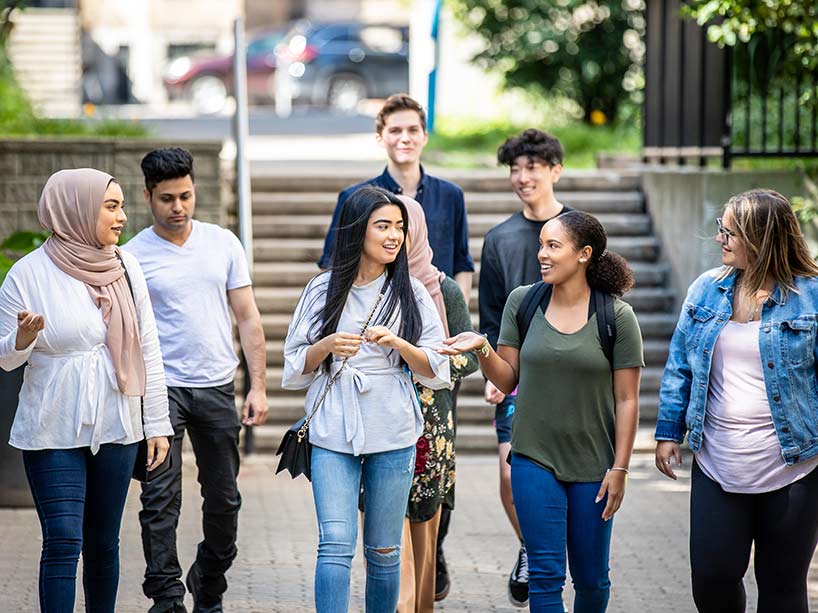Ryerson releases first-ever Student Diversity Self-ID Report

Ryerson’s 2019 Student Diversity Self-ID Report shares the diversity data of its student body, providing representation information using student diversity report cards.
Ryerson University has released its first-ever Student Diversity Self-ID Report, Toward Inclusive Education at Ryerson – providing a snapshot in time of student diversity at Ryerson and identifying areas where the university needs to be more intentional to increase equity, diversity and inclusion.
The first report of its kind for the university, the 2019 Student Diversity Self-ID Report provides diversity data that will serve as a baseline from which the university will measure its progress towards equity, diversity and inclusion. The aspirational goal is to have student representation in each program reflect the GTA or Ontario representation.
“Ryerson can play an important role in leveling the playing field for students from historically and persistently marginalized groups to create equitable opportunities for all students,” said Denise O’Neil Green, vice-president of equity and community inclusion at Ryerson. “Setting targets for improvement will help us measure the success of access initiatives, make changes where necessary and motivate action.”
The report provides representation data for students from five equity groups: women, racialized people, Aboriginal Peoples, persons with disabilities and 2SLGBTQ+ people, as well as the three largest racialized groups at Ryerson and in the GTA: Black, Chinese and South Asian.
There is also a section with special focus on the representation of Black students to better inform the university’s priority to confront anti-Black racism.
"Equity and diversity are essential to Ryerson's continued evolution, as the university is strengthened by the broad ideas and rich experiences that our community members share with one another every day," said Saeed Zolfaghari, interim provost and vice-president, academic. "With this added insight into Ryerson's current student body, we are much better positioned to identify gaps and to create opportunities that will improve representation across our faculties for years to come."
More than 40,000 undergraduate and graduate students completed the Student Diversity Self-ID survey in the 2018-19 academic year – a response rate of 96 per cent.
A vital feature of the report is disaggregated data in the student diversity report cards. While high-level, aggregated data can simplify and summarize the information collected, disaggregated data helps demonstrate the uneven representation of equity and racialized groups across faculties and programs.
Setting and achieving goals
The report provides undergraduate and graduate student diversity report cards which include a grade between A+ and D- for each program at the university, based on its representation of the five equity groups and three largest racialized groups at Ryerson.
From these individual grades, an average program diversity score is calculated. These scores are then used to calculate an overall diversity score for each faculty, which helps identify where targeted action is needed.
In addition to providing general guidelines on setting goals, the report also explains that the steps individual faculties take towards sustained intentional action to address systemic barriers should depend on their unique circumstances and resources.
“There are many programs that are already at or above the GTA and Ontario representation for some or all equity groups,” Green said. “In those programs, the focus should be on intersectionality, inclusion, belonging, student success and experiences that enhance their talents and skills.”
On the other hand, the report also reveals some gaps. It shows how Indigenous students and students with disabilities are substantially underrepresented in both undergraduate and graduate programs, compared with representation in the GTA and Ontario. There is also much lower representation of racialized and Black students in graduate studies, compared to their representation in undergraduate programs.
Intentional and collaborative action
To inspire action and provide a foundation for each faculty to build upon, the report outlines many initiatives already in place at Ryerson that address systemic barriers and increase access to education at the university.
Some of these initiatives involve alternative pathways to Ryerson programs and holistic admissions criteria to address barriers that may prevent students from underrepresented groups from accessing the traditional routes.
For example, the Spanning the Gaps program from The Chang School of Continuing Education and the expanded admissions process in the Faculty of Law provide alternative pathways for students who may otherwise not have these opportunities.
Other actions recommended in the report include developing strategic community partnerships to identify and dismantle barriers, creating scholarships and bursaries that target specific populations and help create opportunities, and planning initiatives that cultivate interest and enthusiasm for programs that may not be traditionally pursued by certain groups.
The report prompts all members of the Ryerson community to work together and collaborate on innovative solutions that can address issues ranging from student recruitment and enrollment to student progress and experience, graduation, career success and maintaining a relationship with the university as alumni.
Driven by the intent to introduce necessary changes at Ryerson that enrich learning and influence societal change, Toward Inclusive Education at Ryerson is a critical tool for the university to be intentionally diverse and inclusive, infusing these values into all aspects of the Ryerson student experience.
